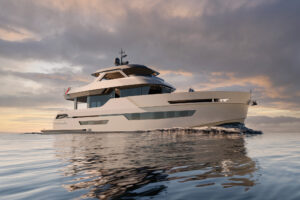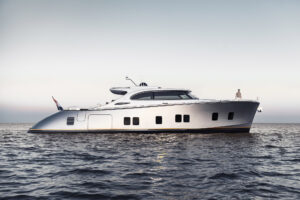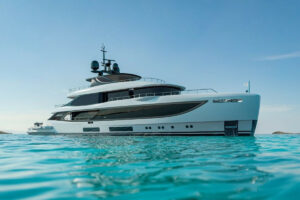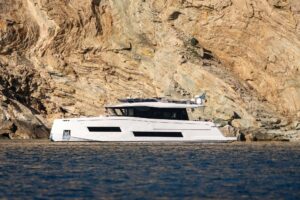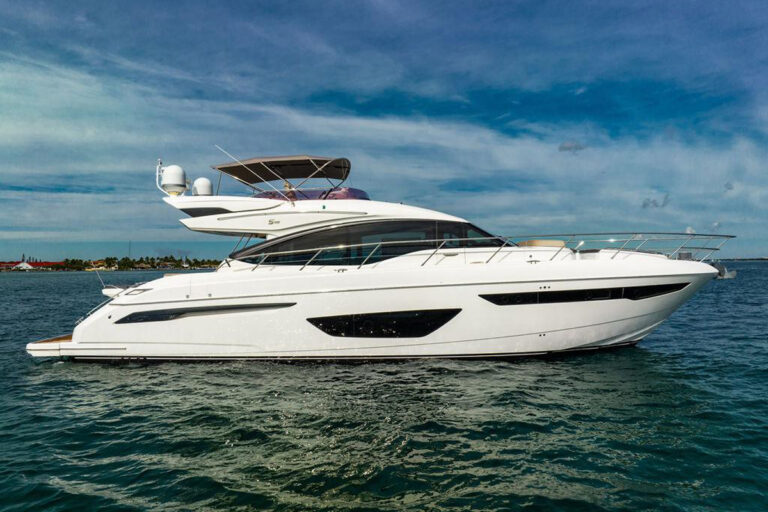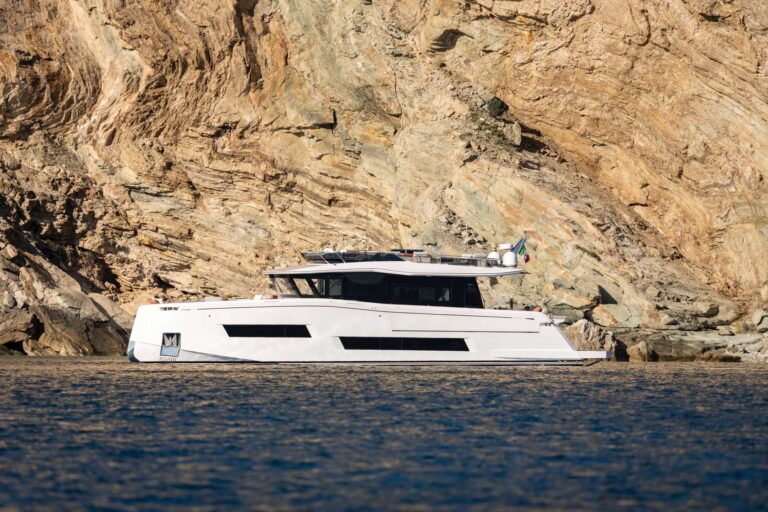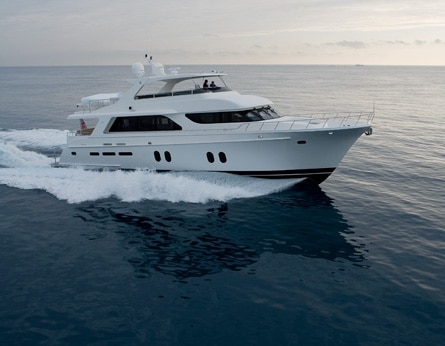
ytgmay08bravo78.jpg
With every new Cheoy Lee yacht I inspect I can’t help but remember the long way this yard has come. Cared for and nurtured by the Lo family for more than a century, Cheoy Lee was one of the first builders I worked with as a young yacht designer 27 years ago. A fleet of Cheoy Lee yachts has been launched since and each seems to set a higher standard for the yard in terms of quality and value. Cheoy Lee’s latest launch, the Bravo 78 motoryacht, is an excellent example.
Cheoy Lee has catered to the U.S. market far longer than the wave of foreign brands that has reached our shores in recent years. Given this, they understand how American yachtsmen use their boats. Founded on Mainland China in 1870, the yard relocated to Hong Kong in 1936. Cheoy Lee got into the yacht business in the 1950s with a series of sailboats and trawlers built of wood. Yachts in fiberglass followed and a series of innovative Tom Fexas-designed sportfishermen and motoryachts helped form the foundation of the yard’s successful yacht-building program. Cheoy Lee outgrew its facility in Hong Kong and moved 60 miles back to the mainland where they opened a state-of-the-art facility on the Pearl River at Doumen in 2000. The 78 is a product of this new yard, which in my opinion is building the best yachts Cheoy Lee has ever brought to market.
The industry standard in terms of fit, finish, and outfitting has been on the rise for the last decade and builders that did not adapt were simply left behind. Cheoy Lee’s solution was to address this challenge with technology. This was, in fact, their approach in the 1980s when the focus was on increasing performance. They were one of the first production boatbuilders to use foam-core materials below the waterline to save weight. In recent years, the yard has been a pioneer in advanced molding processes. The goal now is both performance and quality control.
Most of the 78’s fiberglass parts, including her hull and superstructure, are built using a process in which resin is infused into the laminate in a vacuum. This makes it possible to create parts with near-perfect resin-to-glass ratios. It also reduces weight and waste and leads to a more consistent result. After removing parts from the mold’s exterior, surfaces are prepped and finished with a linear polyurethane coating. The 78’s hull is supported by a foam-cored fiberglass longitudinal stringer system that is supported by foam-cored fiberglass structural bulkheads and web-frames. All tankage is integral with the hull. To reduce weight in the interior, large components and non-structural partitions are cored with foam. Smaller pieces, like interior moldings and doorframes, are resin-infused and covered with veneer.
The 78’s outboard profile is a pleasant refinement of Cheoy Lee designs that have come before. Her relatively straight sheer visually links the modest rake of her stem and her reverse transom. Hull-side windows, a must-have feature these days, shed light into both the owner and VIP staterooms. A fiberglass hardtop shades her bridge and is supported by an integral arch that sweeps forward. This follows the line of the pilaster that supports the overhang covering her side decks aft. Yes, side decks! It seems that at last yachtsmen have rediscovered this handy yet traditional feature. It is possible to safely navigate from the 78’s afterdeck all the way forward to her bow without fear of falling overboard.
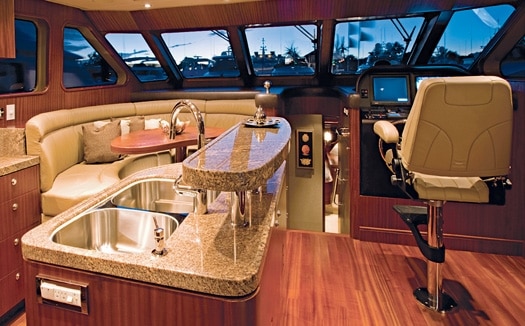
| | |
The 78’s afterdeck is arranged with built-in seating across the transom and a unique split-top varnished teak table with sculptured, polished, stainless steel supports. It’s worth noting that all of the stainless steel work on the 78 is beautifully crafted. A granite- topped wet-bar has a sink and a refrigerator. The bridge deck is accessible from both the interior main deck and the afterdeck. Thanks to the 78’s rather generous 20-foot, 2-inch beam and the length of her deckhouse, the bridge has more real estate than you might expect. There is helm and companion seating and the control console can accommodate at least three large electronic displays. There is a lounge area aft with a varnished teak table as well as a full-service bar with a granite countertop. Aft, a barbecue console is fitted with a stainless steel gas grill and there is space for a 15-foot tender and a crane.
Sylvia Bolton, a Seattle-based designer specializing in yacht interiors, specified our test boat’s interior and the look is in perfect pitch with the American market-a blend of comfort-chic with a sensible American layout. High quality soft goods, fixtures, and hardware accent the expertly crafted satin-finished makori joinery. The saloon is arranged with curved seating areas facing aft and a formal dining table and full-service bar forward. An open galley with a service island and a casual dining area are forward. An interior helm station is small yet adequate should the weather be miserable. Deck access is adjacent to the helm and a day-head is a few steps away.
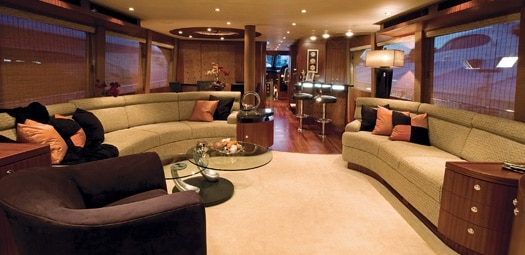
| | |
Cheoy Lee’s goal was to create comfortable accommodations for an owner’s party of six and they avoided the temptation of adding a fourth stateroom. A central spiral staircase leads above to the bridge and below to a foyer common to a full-beam master stateroom and a full-beam VIP stateroom. A third guest stateroom with an island queen is forward and accessible from stairs adjacent to the helm. While some owner operators may be up to the challenge, crew’s quarters aft of the engineroom include a cabin with two berths, a head, and a lounge. Access is from a watertight door in the transom. Should weather make traversing the transom platform dangerous, access through the engineroom via a discreet door in the master shower is possible. This is also an excellent safety feature as it provides a second exit from the engine room.
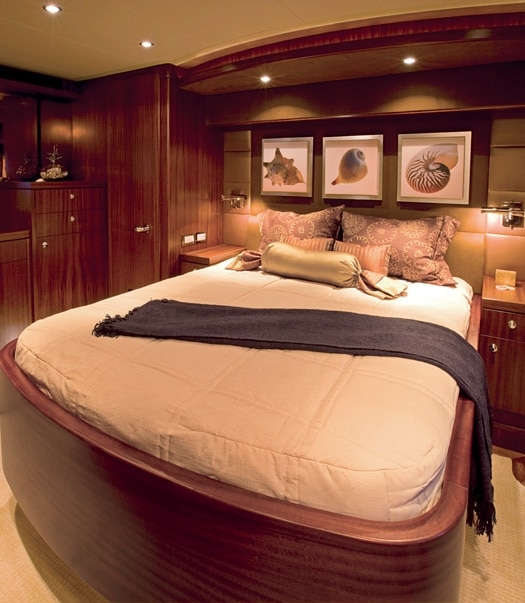
| | |
The engineroom has enough space to move around the engines. 30 kW and 20 kW Northern Lights generators are fitted with sound shields and positioned aft. Auxiliary systems like the chilled-water airconditioning are within easy reach. A fuel-management system with a transfer pump and meter make it possible to balance the load between the two fuel tanks-one at each end of the engineroom. While the 78’s machinery space is trimmed in high-gloss white, it has a stout, ship-like feel. Automatic fire dampers on the air intakes and the tidy piping and wire runs have likely trickled down from Cheoy Lee’s work in the commercial market.
The 78’s design was penned by Mike Burvenich, a graduate of New York’s SUNY Maritime College with a degree in naval architecture. Her hull has a double chine and flared topsides to increase deck beam and interior volume without adding unnecessary wetted surface. The running surface aft is mostly parallel to the static waterline and deadrise at the transom is 14 degrees. A shapely keel design allows these lines to meld into a moderate entry forward where slightly convex sections are intended to reduce impact in head seas. Shallow propeller tunnels reduce shaft angle and draft, which, at 5 feet, 5 inches, makes the 78 suitable for cruising South Florida and the Bahamas. This is roughly the same successful formula that Cheoy Lee has subscribed to over the last decade and the result is a relatively easily driven hull.
I sea-trialed the 78 offshore of Ft. Lauderdale, Florida. Winds were from the southeast at 15 to 20 knots and seas were four feet and building. Our test boat was fitted with a pair of 1,400-horsepower Caterpillar 3412E(s). These engines are an option I would recommend over the standard 1,000-horsepower Cats as the 78 can easily handle the power. I recorded a maximum speed of 23.5 knots (2300 rpm) with the Cats’ electronics indicating 100-percent load. Easing back the throttle to 2100 rpm yielded a very pleasant 21.1 knots at 63-percent load with a fuel burn of 114 gallons per hour. At this setting, Cheoy Lee’s data suggests a potential range of more than 500 nautical miles. Our test boat was fitted with Naiad stabilizers that more than managed the modest challenge the conditions provided. The 78 responded predictably to helm input at speed and her bow and stern thrusters made handling dockside a breeze. Our test boat had a helm remote with plug-in stations aft on the bridge and on the afterdeck. This feature is a must for owner-operators.

| | |
There was a time not so long ago when yachtsmen interested in a motoryacht in the 70- to 80-foot class would have had to seek out a custom builder. Cheoy Lee was a pioneer in meeting this demand with fiberglass production yachts. While there are now a fleet of solid competitors in the market, Cheoy Lee’s experience and willingness to invest in the future is evident in the Bravo 78 and adds to her value.
Cheoy Lee Shipyards North America, (954) 527-0999; www.cheoyleena.com

